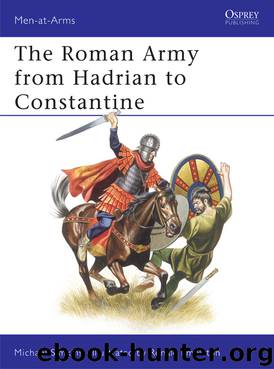The Roman Army from Hadrian to Constantine by Michael Simkins

Author:Michael Simkins
Language: eng
Format: epub
Tags: The Roman Army from Hadrian to Constantine
ISBN: 9781782002215
Publisher: Osprey Publishing
A 3rd century cavalry helmet found at Heddernheim. The helmet is of iron, with embossed and engraved bronze skinning; in this drawing the toned areas are exposed iron. Helmets of this quality are associated with the cavalry regiments (alae). The position of the peak, now lost, is indicated by the dotted line.
The crest fastenings have entirely disappeared from the skull but would, no doubt, have been of the standard Gallic type—a crest stand slide on top of the skull secured with four rivets, with fore and aft ring fastenings to take ties from the ends of the crest. Helmets of Italian origin, where a similar type of crest was used, were fitted with hooks instead of rings, though the practice of wearing brush crests seems to have ceased by the 2nd century with helmets of Italian manufacture. Perhaps the decline of this practice may be witnessed by the highly ornate Italic iron helmet of the second half of the ist century from the River Rhine at Mainz. The helmet is fitted with a large circular stand holder where broad, flat crossbands of thin bronze meet at the top of the skull, but apparently no provision was ever made for crest ties.
The iron helmet said to have been found at Hebron is very different from the Brigetio specimen, though it cannot be said to be any better or worse in quality of manufacture. The most striking features of the helmet are the crossed iron reinforces of half-round section, riveted to the skull at their extremities. In the quarters thus formed, thin bronze lunar ornaments are soldered to the skull, and bring pleasing relief to the mass of the iron.
The elaborately decorated band round the brow of the skull was made from thin bronze with a laurel design, probably produced by die-stamping on lead. Unlike the similar feature on all other extant helmets, the brow band was soldered to a strip of iron attached to the skull, which would certainly brace what was a rather weak area; for although the right-angle of the peak stiffens the frontal part to some extent, the brow edge could suffer damage if a blow was not stopped by the peak, which was the latter’s primary function. The peak itself is of iron, flanged downwards round the exposed edge, and has a strip of thin bronze soldered to the vertical edge formed by the flange. This was also decorated, with circles of small, spaced dots and plain low bosses; similar punched dots also appear on the lunar ornaments as a border with a circle of them at the deepest point of the ornaments.
Another unusual feature of the Hebron helmet is the presence of three steps in the neck-guard, whereas two are normally encountered. There may well have been a carrying handle attached, but unfortunately there remains no evidence of such a fitting, owing to the disappearance of the central area of the neck-guard.
The cheek-pieces have no neck-flanges and are not of a particularly artistic form, unlike those
Download
This site does not store any files on its server. We only index and link to content provided by other sites. Please contact the content providers to delete copyright contents if any and email us, we'll remove relevant links or contents immediately.
| Africa | Americas |
| Arctic & Antarctica | Asia |
| Australia & Oceania | Europe |
| Middle East | Russia |
| United States | World |
| Ancient Civilizations | Military |
| Historical Study & Educational Resources |
The Daily Stoic by Holiday Ryan & Hanselman Stephen(3102)
The Fate of Rome: Climate, Disease, and the End of an Empire (The Princeton History of the Ancient World) by Kyle Harper(2859)
People of the Earth: An Introduction to World Prehistory by Dr. Brian Fagan & Nadia Durrani(2619)
Ancient Worlds by Michael Scott(2492)
Babylon's Ark by Lawrence Anthony(2427)
Foreign Devils on the Silk Road: The Search for the Lost Treasures of Central Asia by Peter Hopkirk(2383)
The Daily Stoic by Ryan Holiday & Stephen Hanselman(2334)
India's Ancient Past by R.S. Sharma(2287)
MOSES THE EGYPTIAN by Jan Assmann(2273)
The Complete Dead Sea Scrolls in English (7th Edition) (Penguin Classics) by Geza Vermes(2134)
Lost Technologies of Ancient Egypt by Christopher Dunn(2103)
The Earth Chronicles Handbook by Zecharia Sitchin(2092)
24 Hours in Ancient Rome by Philip Matyszak(1972)
Alexander the Great by Philip Freeman(1957)
Aztec by Gary Jennings(1874)
The Nine Waves of Creation by Carl Johan Calleman(1778)
Curse Tablets and Binding Spells from the Ancient World by Gager John G.;(1765)
Before Atlantis by Frank Joseph(1738)
Earthmare: The Lost Book of Wars by Cergat(1715)
